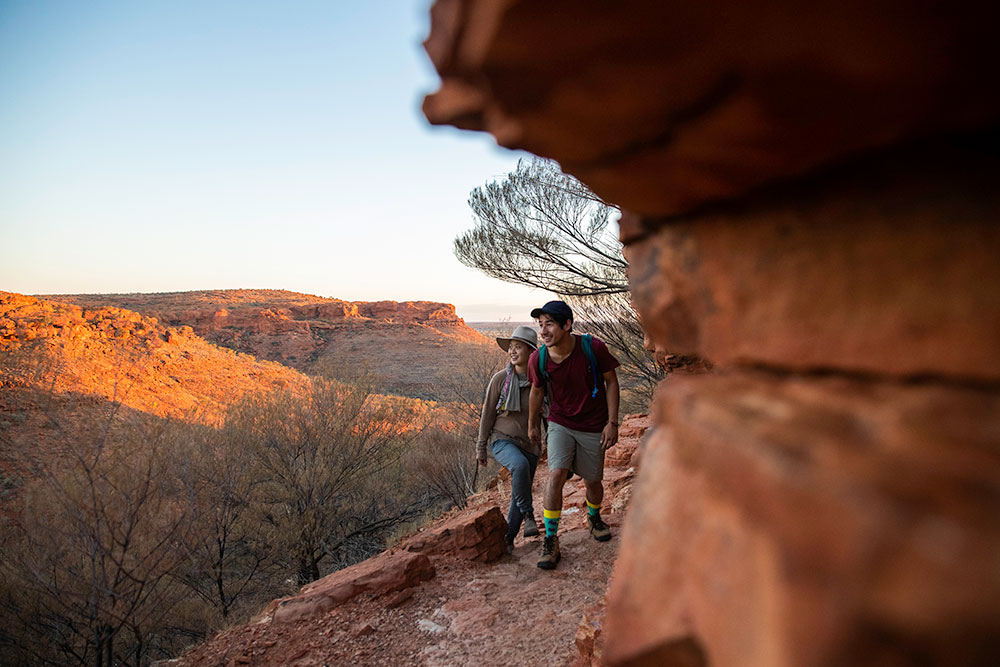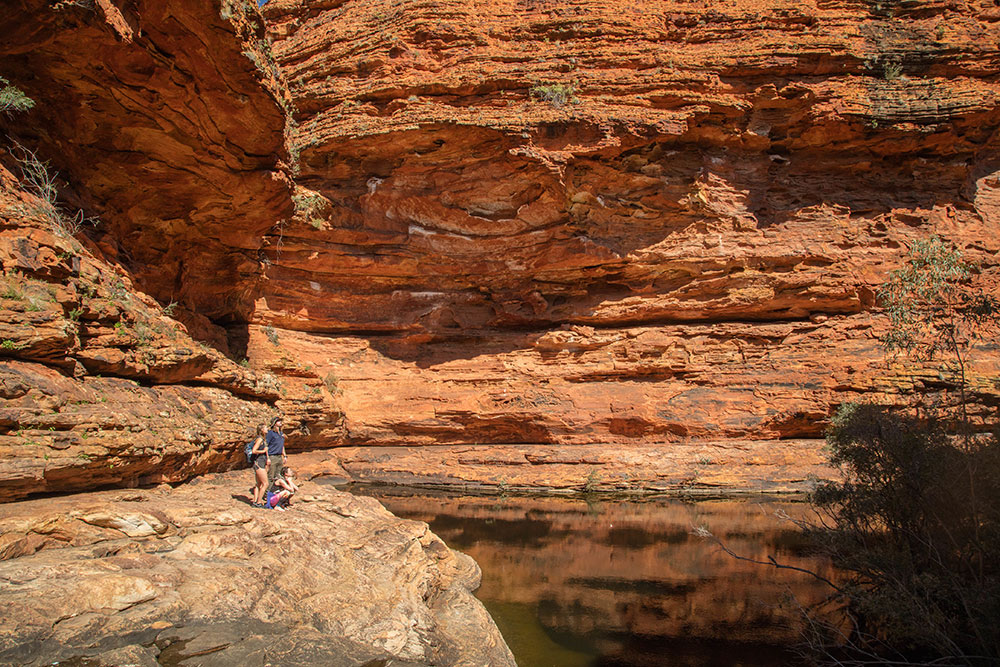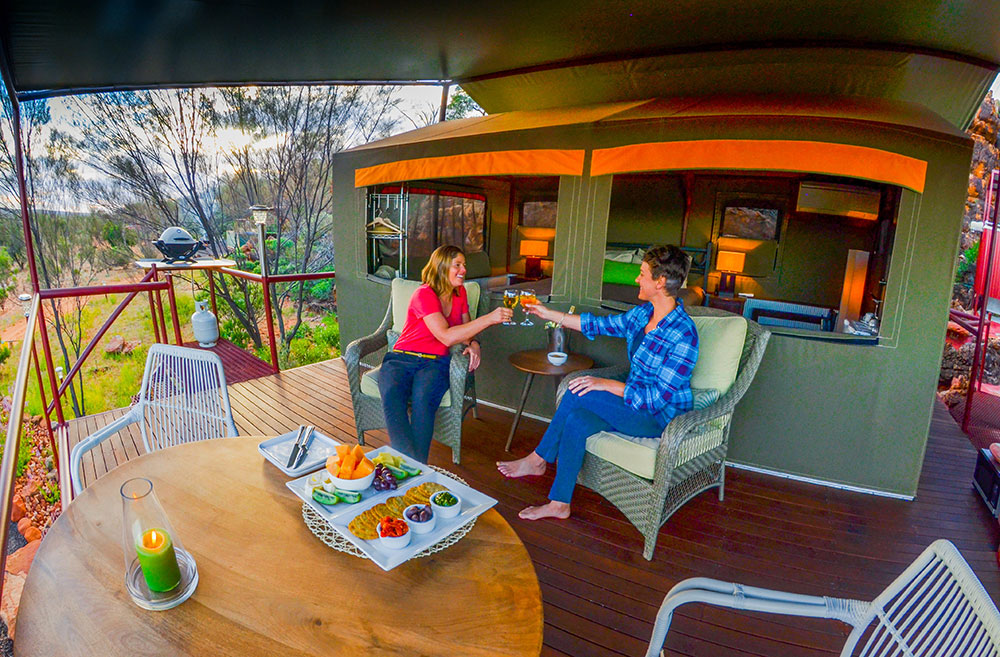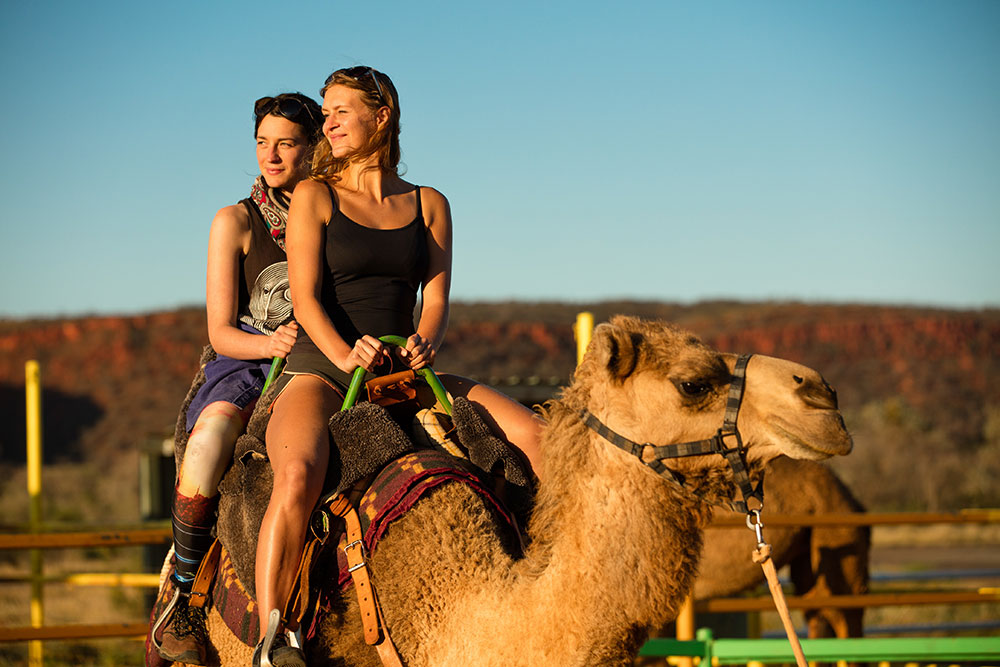Australia's king of canyons
Uluru often steals the limelight in australia’s red centre, but the majestic Kings Canyon shouldn’t be overlooked.

Of all the animals that roam, creep and crawl across Australia’s outback, Marcus Goater says the only one he’s fearful of is the wild camel.
As Marcus tells me of his many outback adventures – including tales of threemonth-long stints wandering through the bush – he bounces across rocks like a kangaroo, guiding me up and around the rim of the Northern Territory’s mighty Kings Canyon at sunrise.
“People say, ‘Oh you must have done this walk thousands of times’, But really, I’ve only done it around 800,” Marcus joked. He has been a guide with AAT Kings for four years, taking guests from Kings Canyon Resort on the 6km rim walk to marvel at 300m-high sandstone walls, some so sheer they look to be machine cut and polished, domes of jagged rock that resemble giant beehives, and peaceful palm-fringed waterholes.
Marcus’ brain is an encyclopedia (if it comes to it, I now know how to make glue out of spinifex) and if you’re into photography, he knows all the best spots.
As Marcus points out plants, fossils and rock formations in the canyon, I feel like I’m ever so slightly getting a grasp on the wonders of this vast land, beyond the obvious spectacular views that keep unfolding in front of me.
This is in part because the guided walk is compounding what I learnt the previous afternoon on a Karrke Aboriginal cultural tour.

Exploring Kings Canyon.
The Karrke experience, which will bump up your knowledge of bush food and medicine along with a range of local cultural practices, is led by Peter Abbott and Christine Breaden.
The couple and their family are from one of the three Aboriginal outstations within Watarrka National Park and, with the blessing of their community, share their local culture with visitors on a onehour tour.
As we move around a series of stations laid out on the bright orange sand, Peter and his sister Natasha take turns explaining traditional baking, cultural ceremonies and weapons, how to get the best sound out of clapping sticks, and how to pierce seeds and nuts to make jewellery using a scorching rod heated by fire.
Finally, we let the cleansing smoke of burning rock fuchsia and weeping emu bush wash over us as we learn about the healing properties of Central Australian flora. The tour operates 2km down the highway from Kings Creek Station, a working cattle property and wild camel exporter.
No, Marcus wasn’t kidding about the camels, they do indeed run wild in the Australian outback to the point of being a pest.
Kings Creek Station is more focused on tourism than camel exporting, but they do have one camel product that remains a mainstay of the business plan – their camel burger.

Relaxing at Kings Creek Station.
Consumed with the guilt-free assurance of pest eradication, it’s delicious.
Kings Creek Station has camping and luxury glamping accommodation options along with permanent bush tents which offer a good middle-of-the-road option.
Even in May, I’m thankful for the heater in my tent, as temperatures in Central Australia vary greatly from season to season and from day to night.
I imagine in summer the air-conditioning would be a godsend, when temperatures can climb into the 40s.
At Kings Canyon Resort, the other major accommodation option in the area, there’s a similar offering – a campground plus six glamping tents, with the addition of simple hotel-style rooms.
Unfortunately, the Under a Desert Moon outdoor fine dining experience wasn’t running when we visited the resort, so instead we followed the throbbing beat of live music to the Outback BBQ & Grill.
Kings Canyon may be remote – it’s more than 300km from the nearest town – but it still knows how to party.

Camel riding at Kings Creek Station.
As I look around, with a giant steak in front of me, I notice that all guests, young and old, seem unable to resist some hand clapping or toe tapping to classics like Jolene and The Horses.
The following evening we dine at the Thirsty Dingo, which is essentially the same venue, just with a different name and different menu, but not before watching the sun throw an intense glow over the canyon before it checks out for the evening.
We follow a trickle of people heading to the resort’s sunset viewing platform.
Sunsets are a big thing in this part of the world, and for good reason. As the sun sinks, the escarpment before us shifts from bright orange to intense red to dusty pink.
Then there’s quiet, and then there are stars.
Kings Canyon is definitely one to add to your list.
PHOTOS: TOURISM NT
CONTACT RACQ TRAVEL TO PLAN YOUR NT HOLIDAY
Related topics
Things to note
The information in this article has been prepared for general information purposes only and is not intended as legal advice or specific advice to any particular person. Any advice contained in the document is general advice, not intended as legal advice or professional advice and does not take into account any person’s particular circumstances. Before acting on anything based on this advice you should consider its appropriateness to you, having regard to your objectives and needs.
Insurance Products (excluding Travel Insurance) are issued by RACQ Insurance Limited ABN 50 009 704 152 (RACQI) and arranged by its agent, RACQ Distribution Services Pty Ltd (RDS) ABN 35 116 361 650, AFSL 567130 and RDS' authorised representatives (including RACQ Operations Pty Ltd ABN 80 009 663 414, AR No. 234978 (RACQO). Conditions, limits and exclusions apply. RDS and RACQO are in the RACQ group of companies. One of the companies in the RACQ group of companies has a minority shareholding in RACQI.
RDS and RACQO have not taken your personal objectives, circumstances or needs into account when preparing advice regarding insurance products and you will need to consider whether the advice is appropriate for you. Read the Product Disclosure Statement (PDS) and any applicable Supplementary PDS before making a purchase decision on this product. You can also access our Target Market Determinations on this website. RDS receives a commission from RACQI for the policies it arranges. RACQO receives fees paid for services it provides to RDS. Further details about remuneration are available on request prior to purchasing.
Banking and loan products issued by Members Banking Group Limited ABN 83 087 651 054 AFSL/Australian credit licence 241195 trading as RACQ Bank. Terms, conditions, fees, charges and lending policies apply. This is general advice only and may not be right for you. This information does not take your personal objectives, circumstances or needs into account. Read the disclosure documents for your selected product or service, including the Financial Services Guide and the Terms and Conditions, and consider if appropriate for you before deciding.
Except for RACQ Bank, any RACQ entity referred to on this page is not an authorised deposit-taking institution for the purposes of the Banking Act 1959 (Cth). That entity’s obligations do not represent deposits or other liabilities of RACQ Bank. RACQ Bank does not guarantee or otherwise provide assurance in respect of the obligations of that entity, unless noted otherwise.
RACQ Bank subscribes to the Customer Owned Banking Code of Practice which establishes higher standards than the law requires. The Code reflects modern consumer expectations and developments in approaches to issues such as consumer vulnerability, guarantors, and supporting customers through financial hardship. Please read our Customer Owned Banking Code of Practice page for more information.
RACQ Operations Pty Ltd (ABN 80 009 663 414 AR 000234978) and Members Travel Group Pty Ltd (ABN 45 144 538 803 AR 000432492) are acting as an Authorised Representative of the issuer of the insurance, Tokio Marine & Nichido Fire Insurance Co., Ltd. (ABN 80 000 438 291 AFSL 246 548). Any advice set out above is general in nature only, and does not take into account your objectives, financial situation or needs. Before purchasing any travel products, please consider the RACQ Travel Insurance Product Disclosure Statement (PDS) and the Target Market Determinations (TMDs) that apply to these products. Whilst the PDS outlines the Terms and Conditions of these products, the TMDs outline the intended class of customers that comprise the target market for these travel products. This will allow you to consider which products best suit your objectives, financial situation and needs and consider the products appropriateness to your personal circumstances. TMDs also outline matters involving the distribution and the review of these products. The PDS, Supplementary PDS and TMDs for each travel product can be found here.